Spatiotemporal Characteristics of the Dominant Modes of Surface Air Temperature Interannual Variations over South China during the Spring-to-Summer Transition
Abstract
:1. Introduction
2. Data and Methods
2.1. Datasets
2.2. Statistical Methods
2.3. Temperature Equation Diagnosis
3. Dominant Modes of SAT Anomalies
4. Roles of Physical Processes in SAT Anomalies
4.1. Surface Heat Flux
4.2. Advection at 1000 hPa
4.3. Comparison of Areal Mean Anomalies
5. Conclusions and Discussion
Author Contributions
Funding
Acknowledgments
Conflicts of Interest
References
- Changnon, S.A.; Kunkel, K.E.; Reinke, B.C. Impacts and responses to the 1995 heat wave: A call to action. Bull. Am. Meteorol. Soc. 1996, 77, 1497–1506. [Google Scholar] [CrossRef]
- Tan, J.; Zheng, Y.; Song, G.; Kalkstein, L.S.; Kalkstein, A.J.; Tang, X. Heat wave impacts on mortality in Shanghai, 1998 and 2003. Int. J. Biometeorol. 2007, 51, 193–200. [Google Scholar] [CrossRef]
- Ding, T.; Ke, Z. Characteristics and changes of regional wet and dry heat wave events in China during 1960–2013. Theor. Appl. Climatol. 2015, 122, 651–665. [Google Scholar] [CrossRef]
- Sun, Y.; Wang, S.; Yang, Y. Studies on cool summer and crop yield in Northeast China. Acta Meteorol. Sin. 1983, 41, 313–321. [Google Scholar]
- Yao, P. The climate features of summer low temperature cold damage in Northeast China during recent 40 years. J. Catastrophol. 1995, 10, 51–56. [Google Scholar]
- Wang, H. The weakening of the Asian monsoon circulation after the end of 1970’s. Adv. Atmos. Sci. 2001, 18, 376–386. [Google Scholar]
- Song, F.; Zhou, T.; Qian, Y. Responses of East Asian summer monsoon to natural and anthropogenic forcings in the 17 latest CMIP5 models. Geophys. Res. Lett. 2014, 41, 596–603. [Google Scholar] [CrossRef] [Green Version]
- Hu, X.; Liu, X. Decadal Relationship between Winter Air Temperature in Northeast China and Arctic Oscillations. J. Nanjing Inst. Meteorol. 2005, 5, 640–648. [Google Scholar]
- Zhuang, Y.; Zhang, J.; Wang, L. Variability of cold season surface air temperature over northeastern China and its linkage with large-scale atmospheric circulations. Theor. Appl. Climatol. 2018, 132, 1261–1273. [Google Scholar] [CrossRef]
- Kang, L.; Chen, W.; Wei, K. The interdecadal variation of winter temperature in China and its relation to the anomalies in atmospheric general circulation. Clim. Environ. Res. 2006, 11, 330–339. [Google Scholar]
- Miyazaki, C.; Yasunari, T. Dominant interannual and decadal variability of winter surface air temperature over Asia and the surrounding oceans. J. Clim. 2008, 21, 1371–1386. [Google Scholar] [CrossRef]
- Xu, X.; Li, F.; He, S.; Wang, H. Subseasonal Reversal of East Asian Surface Temperature Variability in Winter 2014/15. Adv. Atmos. Sci. 2018, 35, 737–752. [Google Scholar] [CrossRef]
- Wang, B.; Yang, S.; Liu, S.; Sun, L.; Lian, Y.; Gao, Z. Changes in the relationship between Northeast China summer temperature and ENSO. J. Geophys. Res. Atmos. 2010, 115, D21. [Google Scholar]
- Wang, B.; Yang, S.; Liu, S.; Sun, L.; Lian, Y.; Gao, Z. Northeast China summer temperature and North Atlantic SST. J. Geophys. Res. Atmos. 2011, 116, D16. [Google Scholar]
- Wang, B.; Zhao, P.; Liu, G. Change in the contribution of spring snow cover and remote oceans to summer air temperature anomaly over Northeast China around 1990. J. Geophys. Res. Atmos. 2014, 119, 663–676. [Google Scholar] [Green Version]
- Chen, W.; Hong, X.; Lu, R.; Jin, A.; Jin, S.; Nam, J.-C.; Shin, J.H.; Goo, T.Y.; Kim, B.-J. Variation in summer surface air temperature over Northeast Asia and its associated circulation anomalies. Adv. Atmos. Sci. 2016, 33, 1–9. [Google Scholar] [CrossRef]
- Liang, P.; Lin, H.; Ding, Y. Dominant modes of subseasonal variability of East Asian summertime surface air temperature and their predictions. J. Clim. 2018, 31, 2729–2743. [Google Scholar] [CrossRef]
- Wu, R.; Wang, B. Interannual variability of summer monsoon onset over the western North Pacific and the underlying processes. J. Clim. 2000, 13, 2483–2501. [Google Scholar] [CrossRef]
- Wu, R.; Wang, B. Multi-stage onset of the summer monsoon over the western North Pacific. Clim. Dyn. 2001, 17, 277–289. [Google Scholar] [CrossRef]
- He, Z.; Wu, R. Seasonality of interannual atmosphere–ocean interaction in the South China Sea. J. Oceanogr. 2013, 69, 699–712. [Google Scholar] [CrossRef]
- Wu, R.; Hu, W. Air–Sea Relationship Associated with Precipitation Anomaly Changes and Mean Precipitation Anomaly over the South China Sea and the Arabian Sea during the Spring to Summer Transition. J. Clim. 2015, 28, 7161–7181. [Google Scholar] [CrossRef]
- Wu, R.; He, Z. Two Distinctive Processes for Abnormal Spring to Summer Transition over the South China Sea. J. Clim. 2017, 30, 9665–9678. [Google Scholar] [CrossRef]
- He, J.; Zhu, Q.; Murakami, M. TBB data-revealed features of Asian-Australian monsoon seasonal transition and Asian summer monsoon establishment. J. Trop. Meteorol. 1996, 12, 34–42. [Google Scholar]
- Zhang, Y.; Wu, G. Diagnostic Investigations on the Mechanism of the Onset of Asian Summer Monsoon and Abrupt Seasonal Transitons over the Northern Hemisphere Part: II The Role of Surface Sensible Heating over Ti Betan Plateau and Surrounding Regions. Acta Meteorol. Sin. 1999, 57, 56–73. [Google Scholar]
- Yao, S.; Zhang, Y. Effects of Surface Heat Flux on Surface Air Temperature Variation Trend in East Asia Region from Spring to Summer. Plateau Meteorol. 2007, 26, 240–248. [Google Scholar]
- Fan, Y.; Van den Dool, H. A global monthly land surface air temperature analysis for 1948–present. J. Geophys. Res. Atmos. 2008, 113, D1. [Google Scholar] [CrossRef]
- Matei, D.; Pohlmann, H.; Jungclaus, J.; Müller, W.; Haak, H.; Marotzke, J. Two tales of initializing decadal climate prediction experiments with the ECHAM5/MPI-OM model. J. Clim. 2012, 25, 8502–8523. [Google Scholar] [CrossRef]
- Garcia-Serrano, J.; Frankignoul, C. High predictability of the winter Euro–Atlantic climate from cryospheric variability. Nat. Geosci. 2014, 7, E1. [Google Scholar] [CrossRef]
- Willmott, C.J.; Matsuura, K. Terrestrial Air Temperature and Precipitation: Monthly and Annual Time Series (1950–1996). 2001. Available online: http://climate.geog.udel.edu/~climate/html_pages/README.ghcn_ts2.html (accessed on 3 February 2019).
- Kalnay, E.; Kanamitsu, M.; Kistler, R.; Collins, W.; Deaven, D.; Gandin, L.; Iredell, M.; Saha, S.; White, G.; Woollen, J.; et al. The NCEP/NCAR 40-Year Reanalysis Project. Bull. Am. Meteorol. Soc. 1996, 77, 437–472. [Google Scholar] [CrossRef]
- Kobayashi, C.; Iwasaki, T. Brewer-Dobson circulation diagnosed from JRA-55. J. Geophys. Res. Atmos. 2016, 121, 1493–1510. [Google Scholar] [CrossRef]
- North, G.R.; Bell, T.L.; Cahalan, R.F.; Moeng, F.J. Sampling Errors in the Estimation of Empirical Orthogonal Functions. Mon. Weather Rev. 1982, 110, 699–706. [Google Scholar] [CrossRef] [Green Version]
- Zhang, X.H.; Yu, Y.Q.; Liu, H. Wintertime North Pacific surface heat flux anomaly and air-sea interaction in a coupled ocean-atmosphere model. Sci. Atmos. Sin. 1998, 22, 511–521. [Google Scholar]
- Li, D.; Li, W.; Li, W.; Lanzhi, L.; Hailing, Z.; Guoliang, J. A diagnostic study of surface sensible heat flux anomaly over the Qinghai-Xizang Plateau. Clim. Environ. Res. 2003, 8, 71–83. [Google Scholar]
- Zhu, X.-S.; Zhang, Y.-C. Parameterization of subgrid topographic slope and orientation in numerical model and its effect on regional climate simulation. Plateau Meteorol. 2005, 24, 136–142. [Google Scholar]
- Li, Y.; Li, J.; Kucharski, F.; Feng, J.; Zhao, S.; Zheng, J. Two leading modes of the interannual variability in South American surface air temperature during austral winter. Clim. Dyn. 2018, 51, 2141–2156. [Google Scholar] [CrossRef]
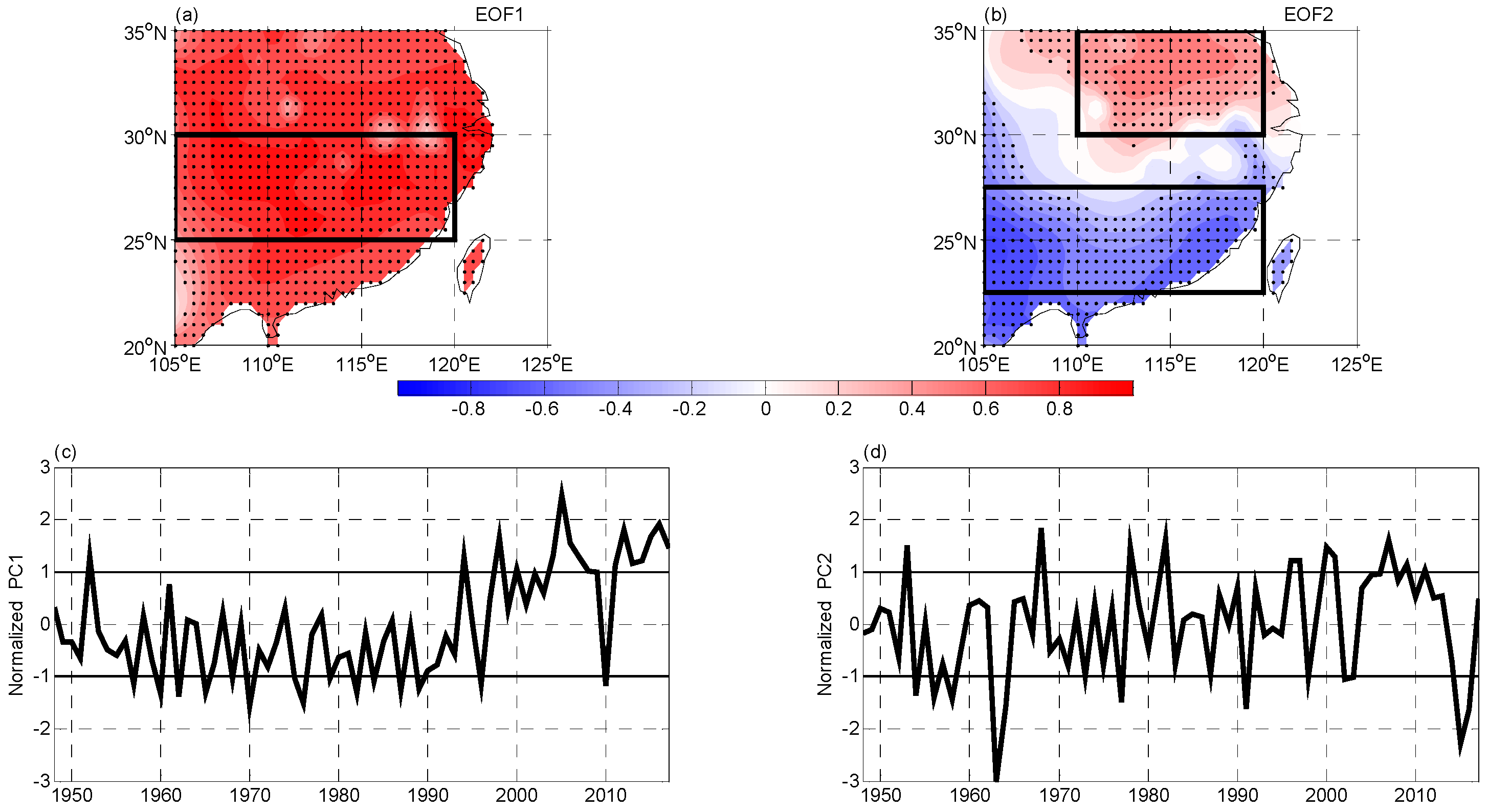
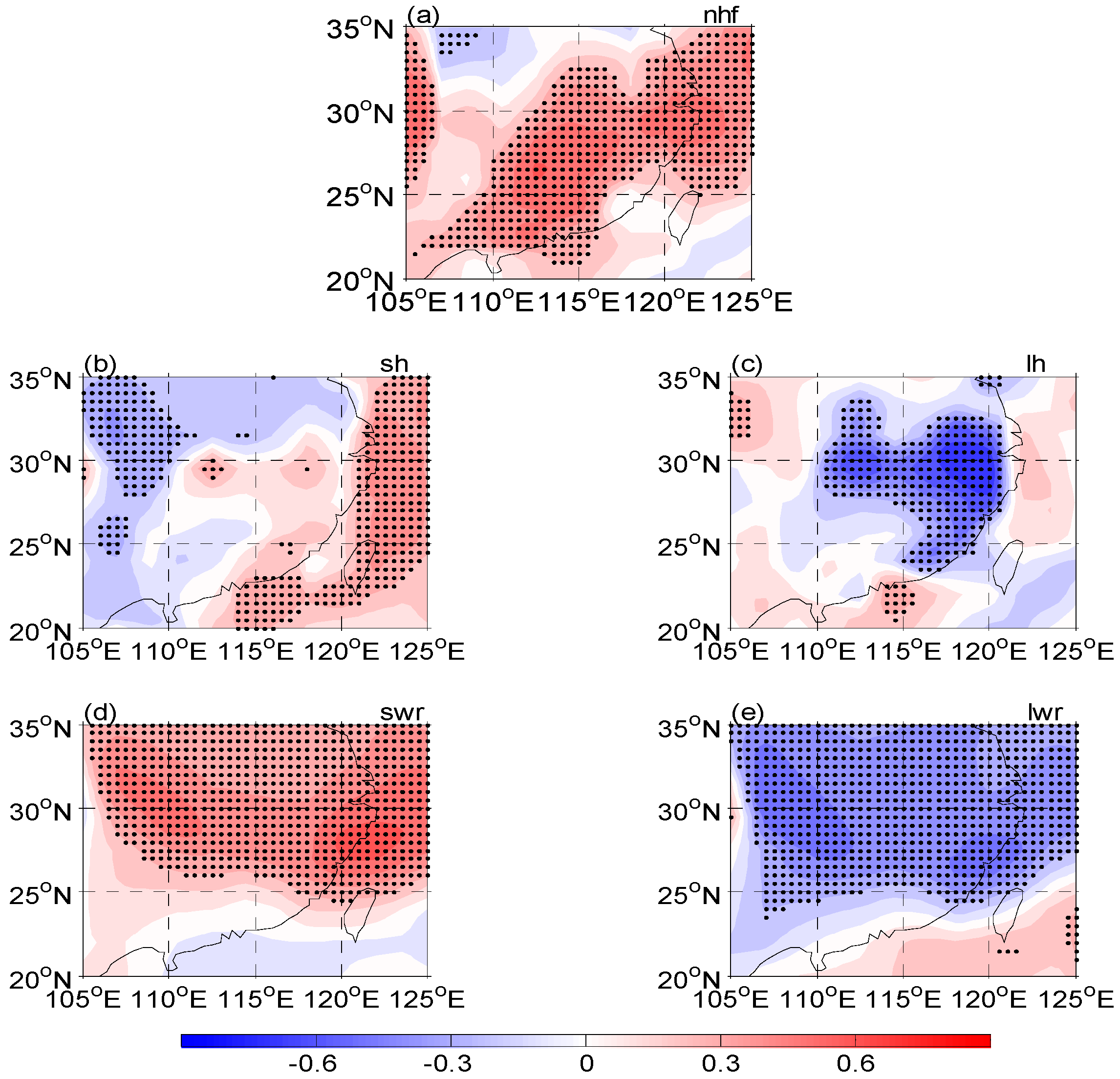
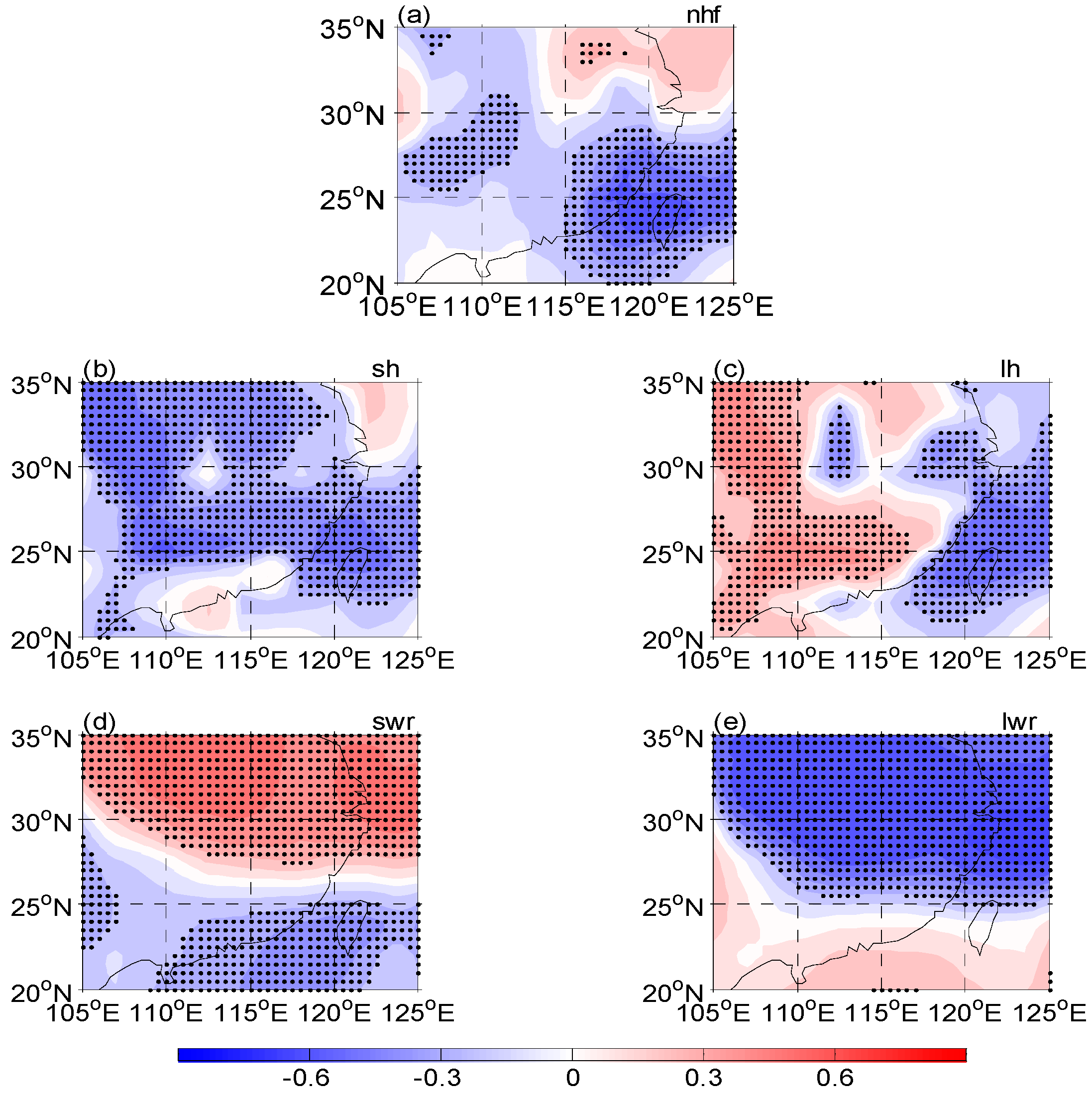
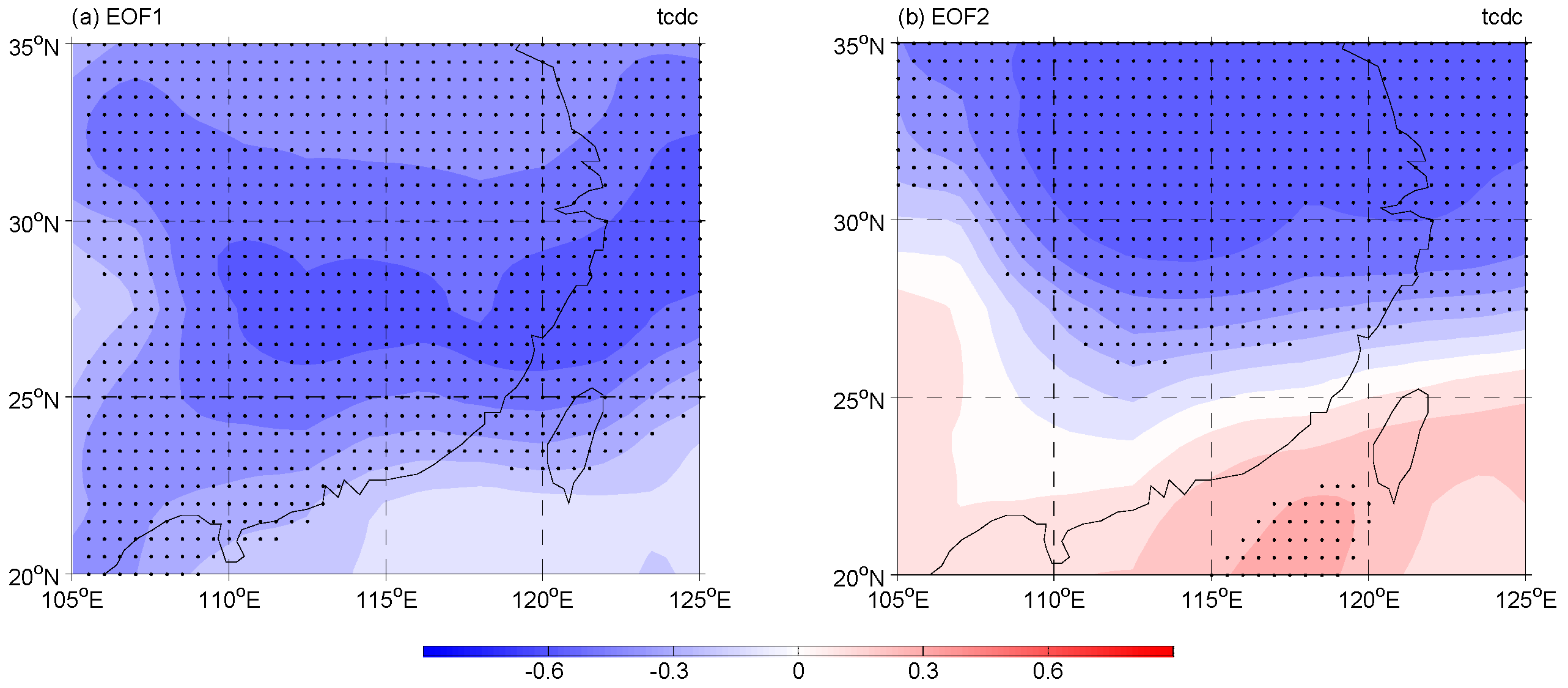
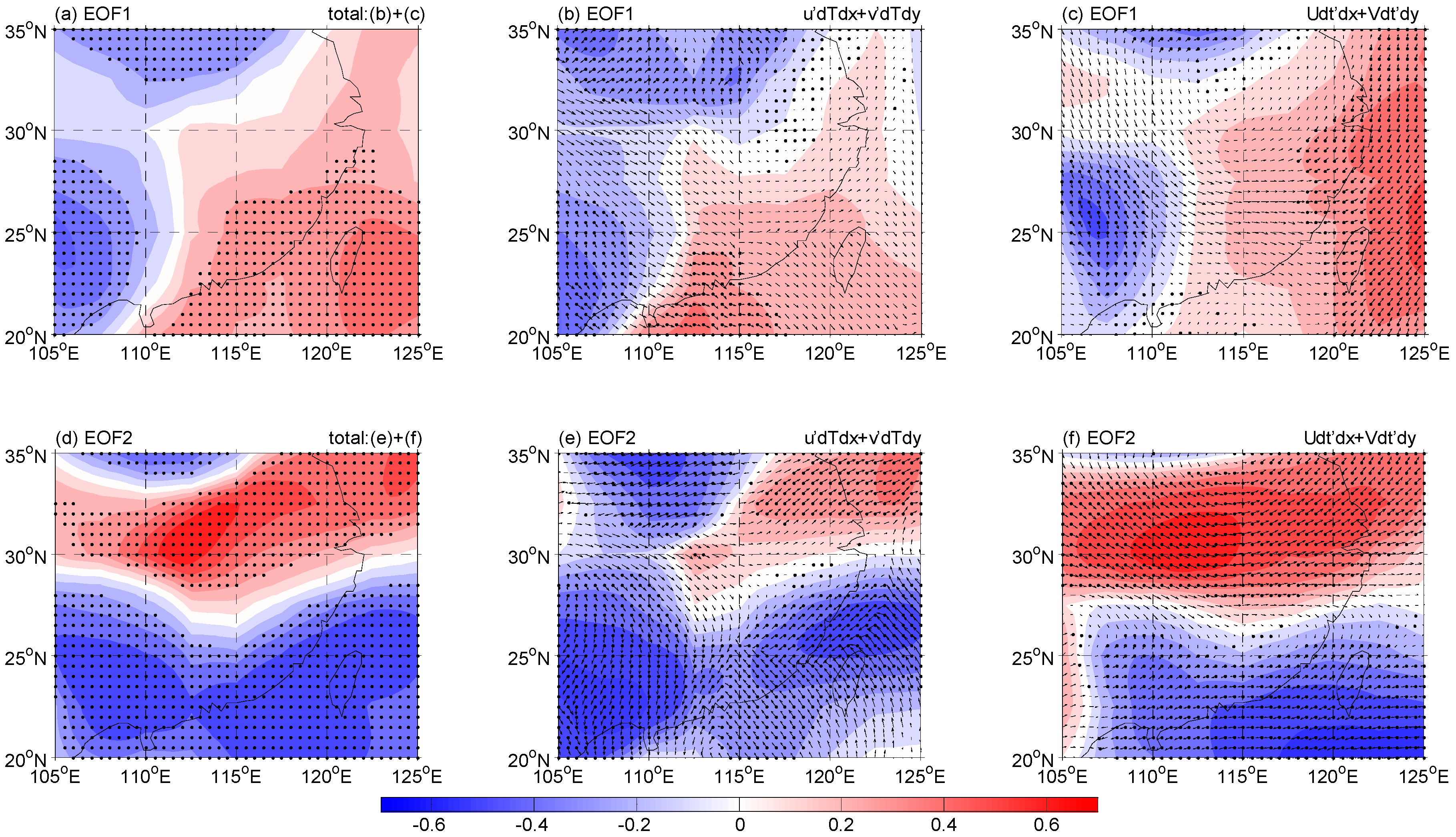
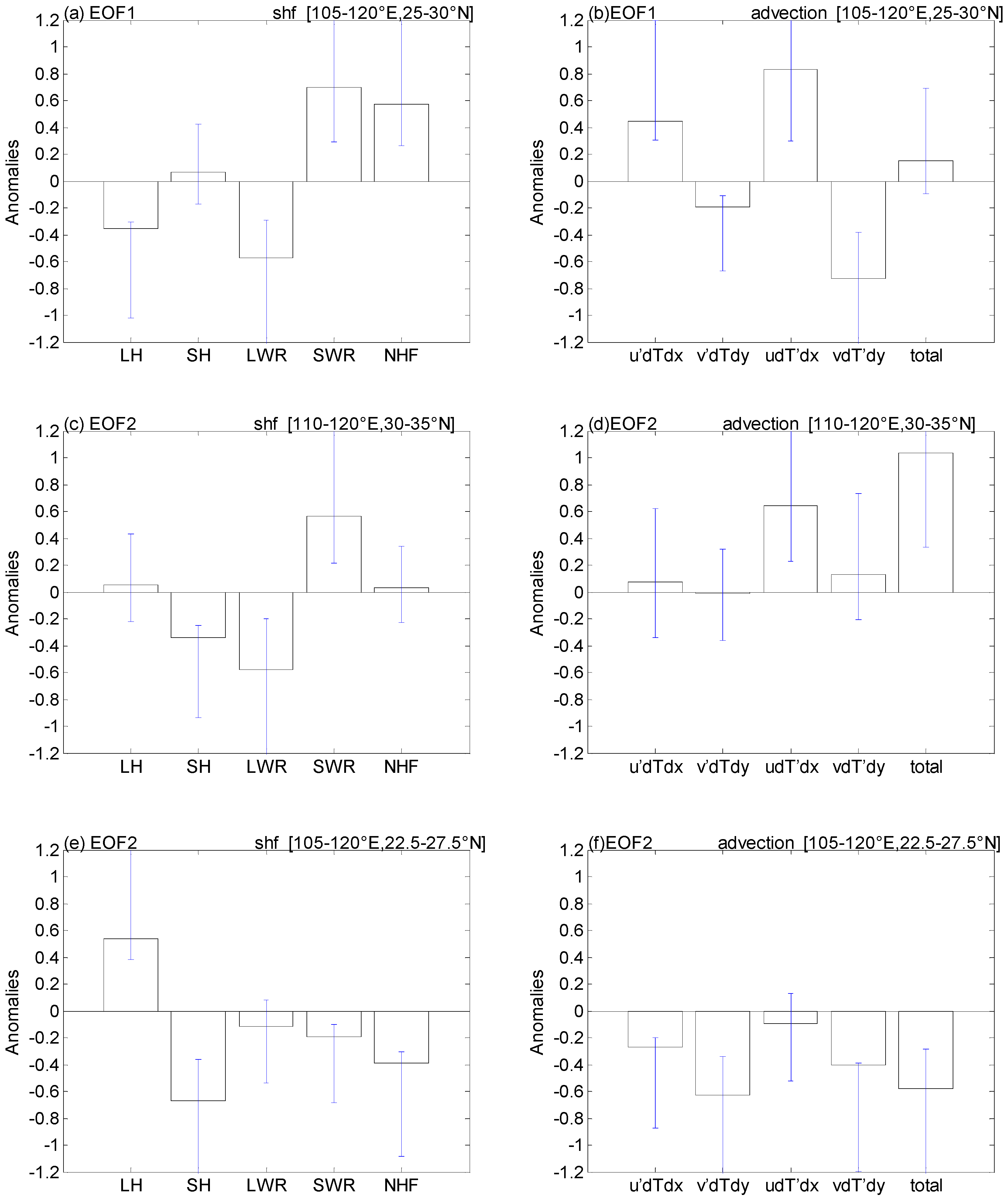
© 2019 by the authors. Licensee MDPI, Basel, Switzerland. This article is an open access article distributed under the terms and conditions of the Creative Commons Attribution (CC BY) license (http://creativecommons.org/licenses/by/4.0/).
Share and Cite
Wang, F.; Li, Y.; Li, J. Spatiotemporal Characteristics of the Dominant Modes of Surface Air Temperature Interannual Variations over South China during the Spring-to-Summer Transition. Atmosphere 2019, 10, 65. https://doi.org/10.3390/atmos10020065
Wang F, Li Y, Li J. Spatiotemporal Characteristics of the Dominant Modes of Surface Air Temperature Interannual Variations over South China during the Spring-to-Summer Transition. Atmosphere. 2019; 10(2):65. https://doi.org/10.3390/atmos10020065
Chicago/Turabian StyleWang, Fen, Yaokun Li, and Jianping Li. 2019. "Spatiotemporal Characteristics of the Dominant Modes of Surface Air Temperature Interannual Variations over South China during the Spring-to-Summer Transition" Atmosphere 10, no. 2: 65. https://doi.org/10.3390/atmos10020065




